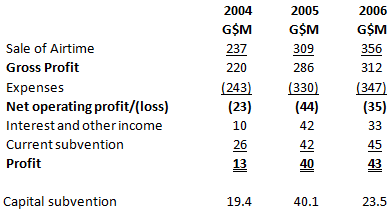Introduction
Last week we sought to conclude our review of the financial statements of NCN for the three years from 2004 to 2006. Readers will recall that NCN recorded losses in each of the three years but massaged each year’s loss into a profit as a result of subventions from the state. Such operating subventions came to an abrupt end with President Ramotar’s assent to the legislation withdrawing $81 million of proposed subvention although an amount of $65 million has been approved under the Office of the President for capital expenditure for NCN.
I commented last week on the poor quality of the information contained in the audited financial statements as well as on what appears to be unacceptably poor audit quality by Mr Deodat Sharma, long acting Auditor General. NCN does not show segmented information derived from its distinct operations such as Television and Radio, and it was not therefore possible to analyse the information presented. Using the revenue numbers for 2006 and applying available television hours only, the recovery rate hovers around 20%. If, as must be the case, part of the reported revenues is derived from radio then something is seriously wrong with the marketing, management, finance and production departments of the company.
It boggles the mind that an entity that generates revenue of more than half-a-billion dollars, that enjoys very known tax concessions, that has access to all the material of the government‘s formidable information capacity and that has not had to meet any economic or commercial test, cannot make a profit. But let us move on to the Guyana National Newspapers Limited, the printers and publishers of the Guyana Chronicle which boasts on its masthead that it is the country’s most widely circulated newspaper.
GNNL
In my research for today’s column I found that the company had very recently submitted to the Registrar of Companies its 2007 and 2008 financial statements and reports contained in a single good quality report that fails to identify its printer. While welcoming the apparent attempt at improved filings with a view to eventual compliance with the law, one must still wonder why the filing for 2007 was not done ever since the audit report was issued in October 2008. This comment applies too in respect of 2008, the audit report for which was issued since November 2009.
One cannot be sure why the Chairman Keith Burrowes, an advocate of accountability, would have held back on the 2007 report in which he reported on exceedingly favourable performance by the company and failed to address for 2008 some of the operational challenges facing the company, including a balance sheet that does not show a true and fair view. Surely any responsible chairman would follow the advice of his auditors and make some provision against doubtful debts.
Big loss
In his 2008 report he simply acknowledged the loss and then looked for its causes. What he failed to explain however is how in the space of one year the company can turn a profit of $26.2 million into loss of $7.3 million. To be fair, the directors do state in their report that the concept of good corporate governance has become one of the company’s cornerstones, and that it has an internal auditor who reports to the Chairman. The legal advisor is listed as Ms Jaya Manickchand who enjoys political connections with the government and who was recently made a Gecom Commissioner by the PPP/C.
Despite the welcome appointment of an internal auditor, one of the first things to note is that the audit report has moved from a clean opinion in 2006 and 2007 to an adverse opinion in 2008 in which the auditor indicates that the company’s financial statements do not give a true and fair view of the company’s financial position, its performance and its cash flows for the year. This extreme position was taken by the auditors because of the uncertainty that some $50 million shown as receivables will be collected. If these, as the auditors fear, are not recovered then some 18% of the total assets of the company will have vanished.
The Board it seems is in denial about these balances, and one must wonder how many are political debts for the 2006 elections or for the supply of newspapers to government agencies and departments, which are practically imposed. At some point the company has to bite the bullet or the auditor may have to withdraw from the engagement.
Significantly, there are no notes on related party transactions or balances making the claim of good corporate governance hollow, even by way of discussions.
Statement of income
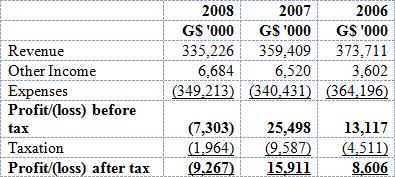
Source: Audited financial statements
As the table above shows revenue has fallen in both 2007 and 2008 with a reduction in revenue in 2008 of $2 million per month, or roughly 7%, or 10% over the two years 2006 to 2008. In 2007 the company cushioned the $14 million fall in revenue by reducing expenditure by $20 million, as a result of which profits almost doubled. By contrast, in 2008 expenditure actually increased while sales declined, the classic double whammy.
According to Chairman Mr Keith Burrowes, the increase was due primarily to higher raw material costs which account for 23% of total expenditure, fuel and electricity 6% and labour 41%. The company must be one of the few entities that has managed to reduce their electricity/fuel costs, doing so by a whopping 18%. The company too, must be one of the first public sector entities in recent times to engage in voluntary staff reduction with the labour force declining from 117 employees in 2003 to 93 in 2008, or the equivalent of one lay-off for every five! Labour cost in the same period has shown an interesting curve dipping between 2004 and 2007 but then jumping by 15% in 2008. Average annual employment cost per person increased significantly over the period:
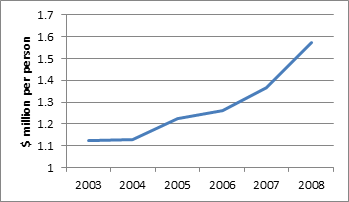
Source: Chairman’s report 2008
What was also noticeable was that even when the company slashed the number of staff from 102 to 92 in 2007, its salary bill declined by a mere 2.4%, suggesting that it was the low level staff who were terminated.
Statement of financial position
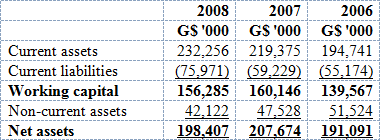
Source: Audited financial statements
I have already referred to the concerns of the auditors about the receivables figure which must inevitably include substantial amounts owed by government agencies. I would add another caveat and that is in relation to the level of inventories which showed a 51% increase in 2008 over 2007, from $37 million to $56.0 million. The company’s circulation is falling to what would normally be considered unsustainably low levels, and one has to speculate on the rationality of buying newsprint when the prices are at one of their historic peaks. In any case, unless the entire industry in Guyana and abroad has it wrong, the company’s inventory holding makes no commercial sense.
For a full four years, the balance sheet of the company has been carrying a dividend payable figure of $18.1 million and one must wonder why the Privatisation Unit/NICIL, which claims to consolidate GNNL’s financial statements into its own, has not taken up these dividends given that they became legally due when passed at the relevant AGM.
Falling circulation
But with all the deniability of its receivables and the uncertainty about its inventories, the real story of GNNL is best told in its circulation numbers. On page 25 of the 2008 annual report there is a chart intituled Circulation Average (2004-2008). While the directors deserve credit for this disclosure, the manner in which the time series run is misleading. The numbers on the left of the chart are the lowest and instinct would lead one to think that the upward movement to the right points to higher circulation in the later years. Alas, it is just the opposite. The reader reviewing the chart from right to left soon realizes that the circulation has in fact been falling and the bars on the left – the lowest – are the most recent, ie, up to 2008. A clearer presentation is as follows:
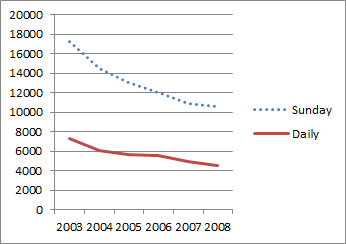
Chart: Circulation figures 2003 – 2008
A closer look at revenue from newspaper circulation reveals an average 33% discount on the cover price which might be considered high for the industry. To add to the effective cost, the company spends almost 25% of net circulation revenue on circulation costs and therefore incurs total costs of almost 50% on the cover price. Advertising income represents 64.9% of total income in 2008 compared to 59.9% in 2006 and no doubt a substantial proportion of that income is from government. But there is a complete lack of disclosure of related party transactions from which one would have been able to determine the exact influence on the company. These are some of the issues which Mr Burrowes chose to side-step.
Conclusion
This review has highlighted the many failings of the accounting and auditing of the two major commercial communication arms of the state. The fuzzy accounting at NCN was below even the most modest standard of acceptability while the financial statements of the Chronicle company have been certified as wrong and misstated.
Chronicle is heading for some real challenges, while the NCN will soon be forced to run like a business. Unfortunately, given the number of years in arrears, Guyanese will have to endure many more annual reports before we have an insight into how they cope.

